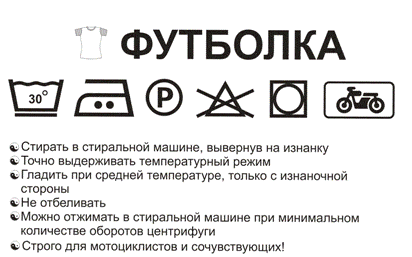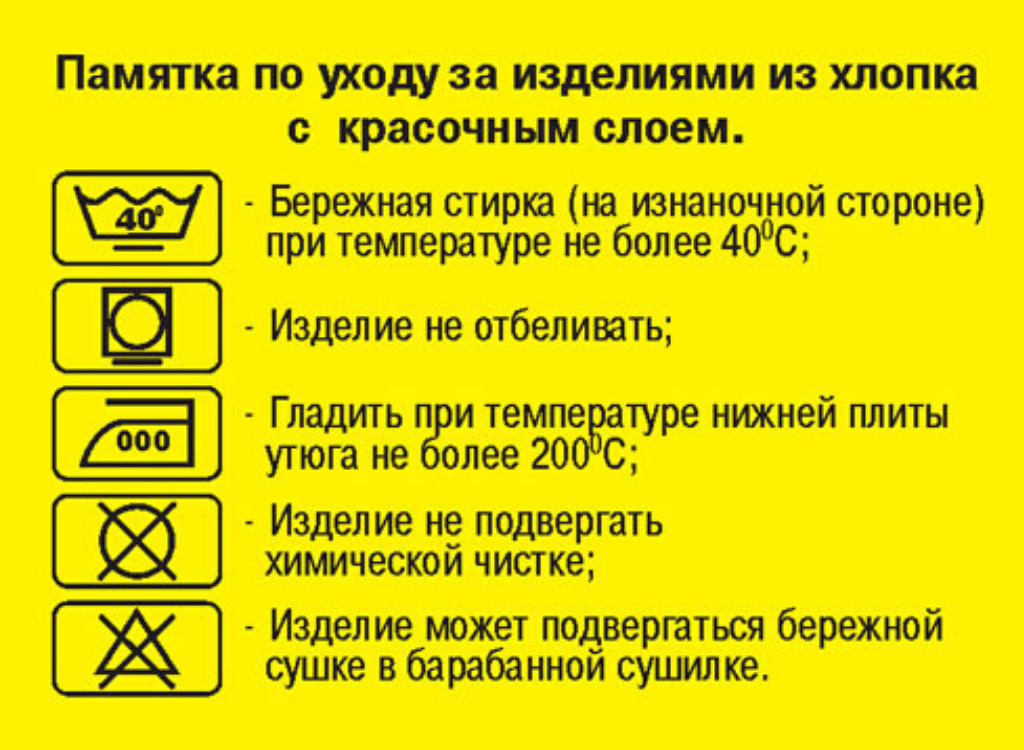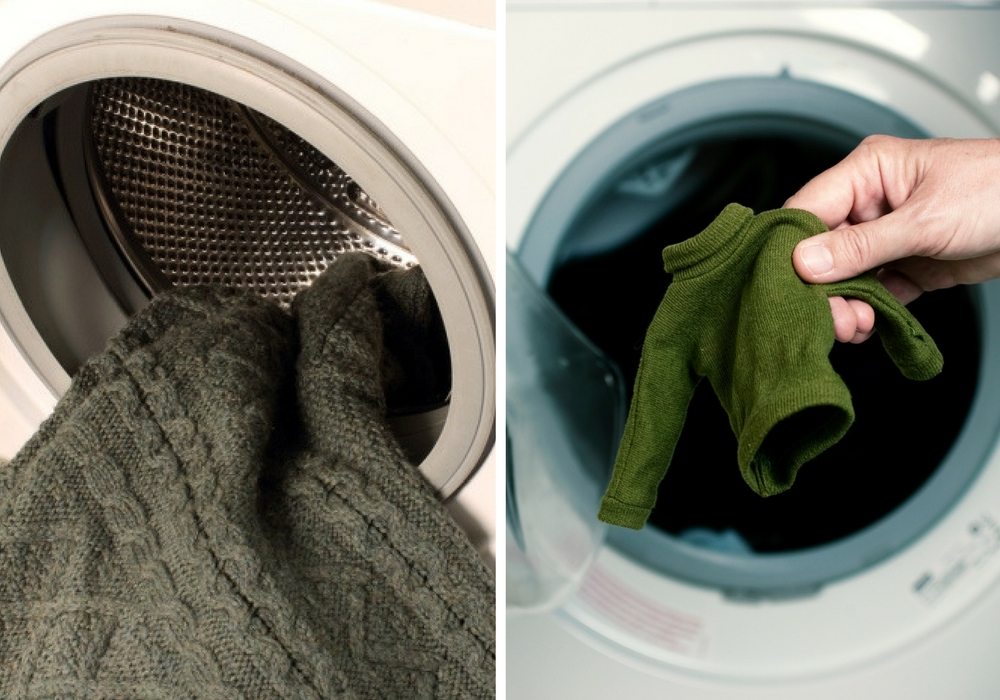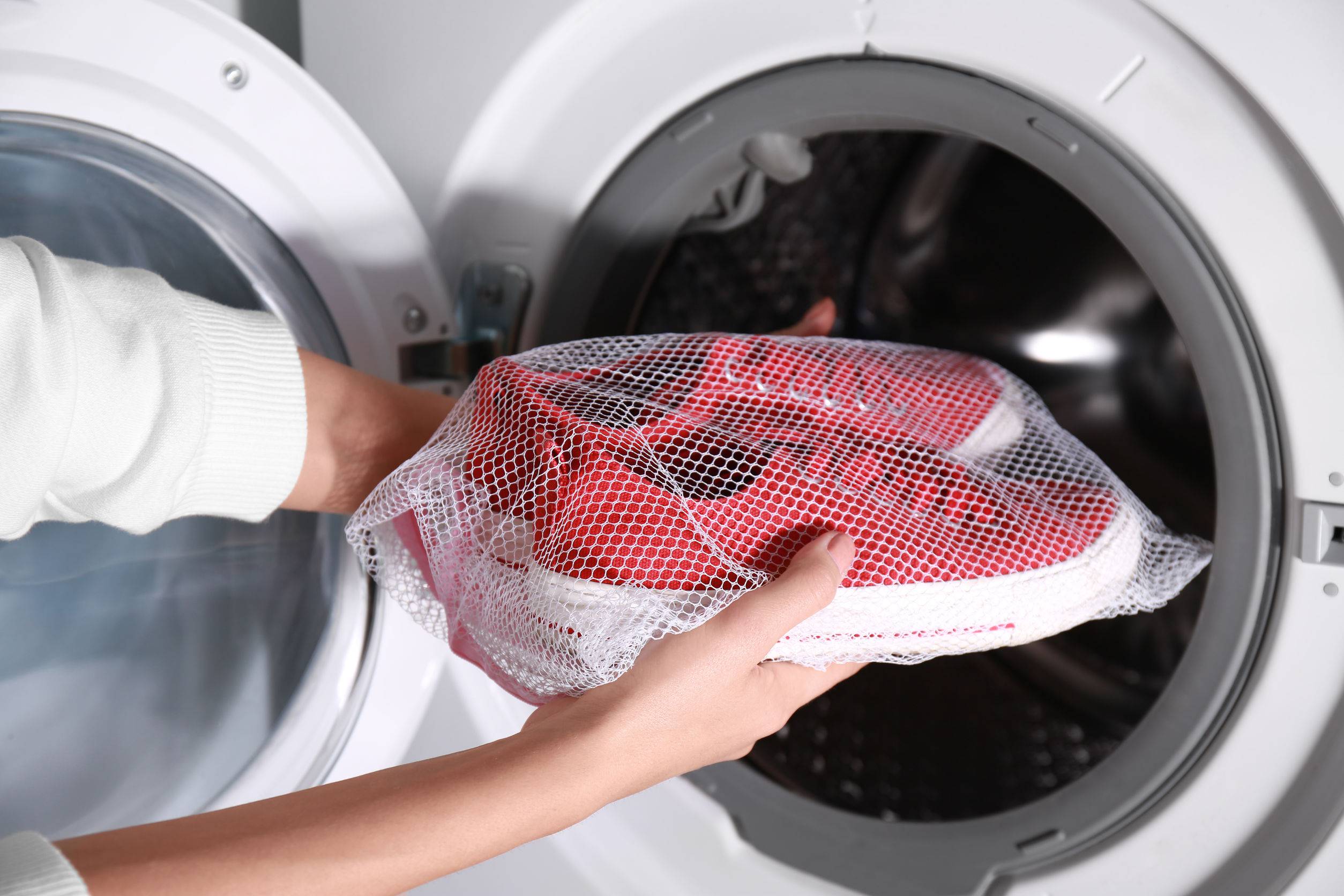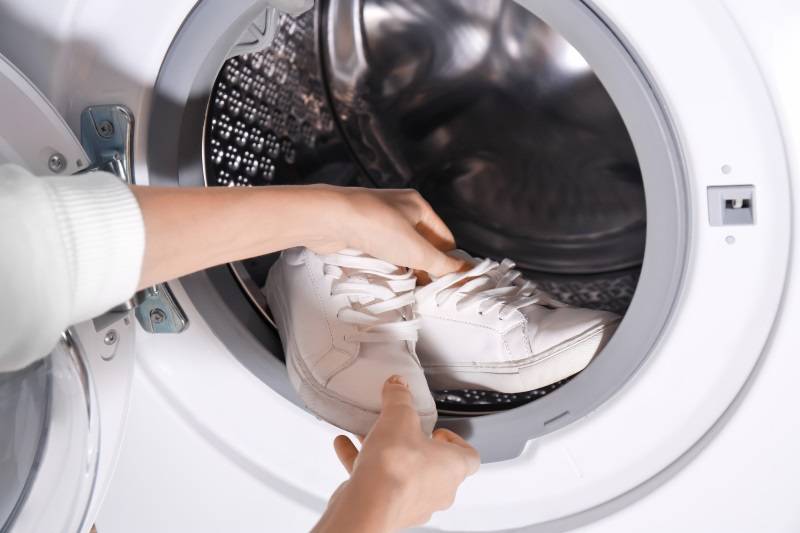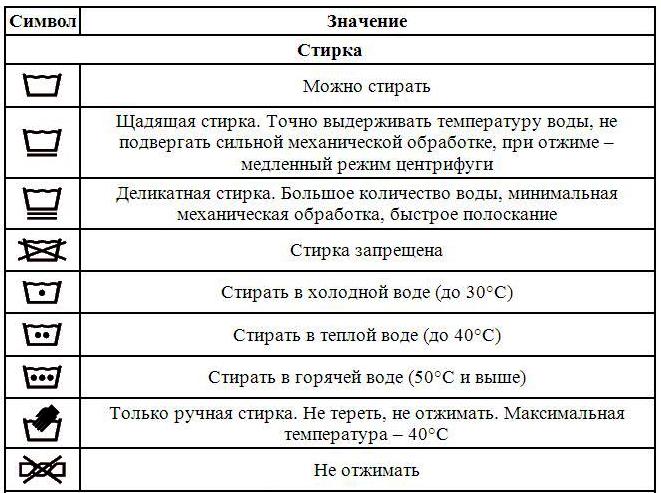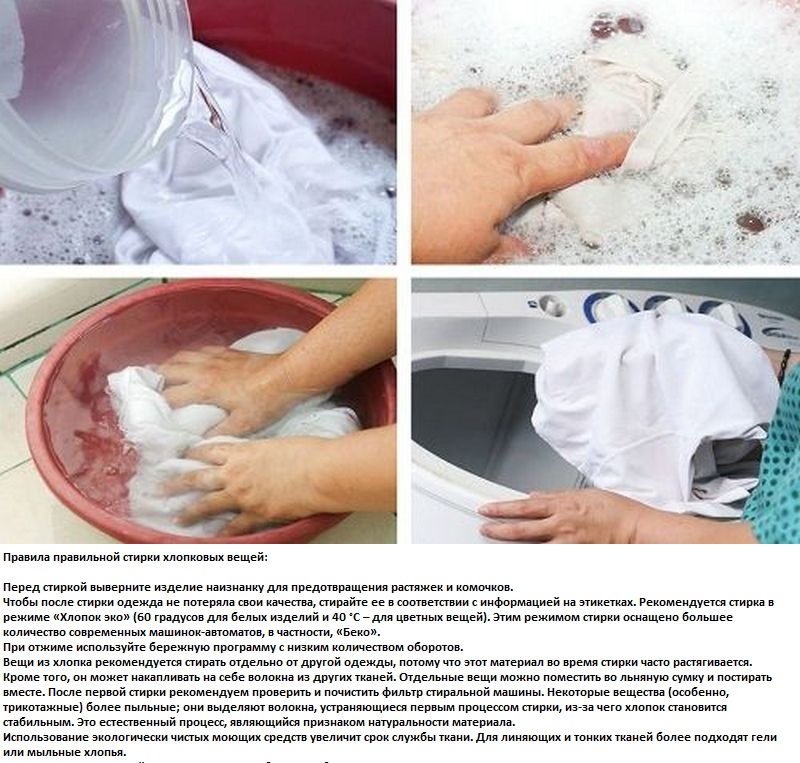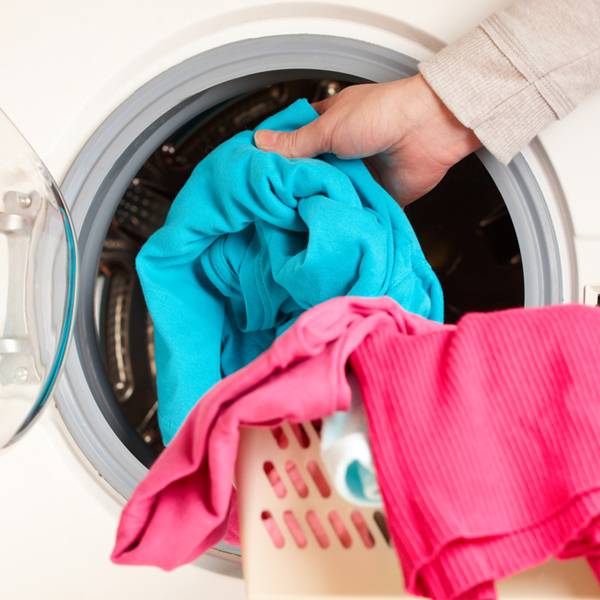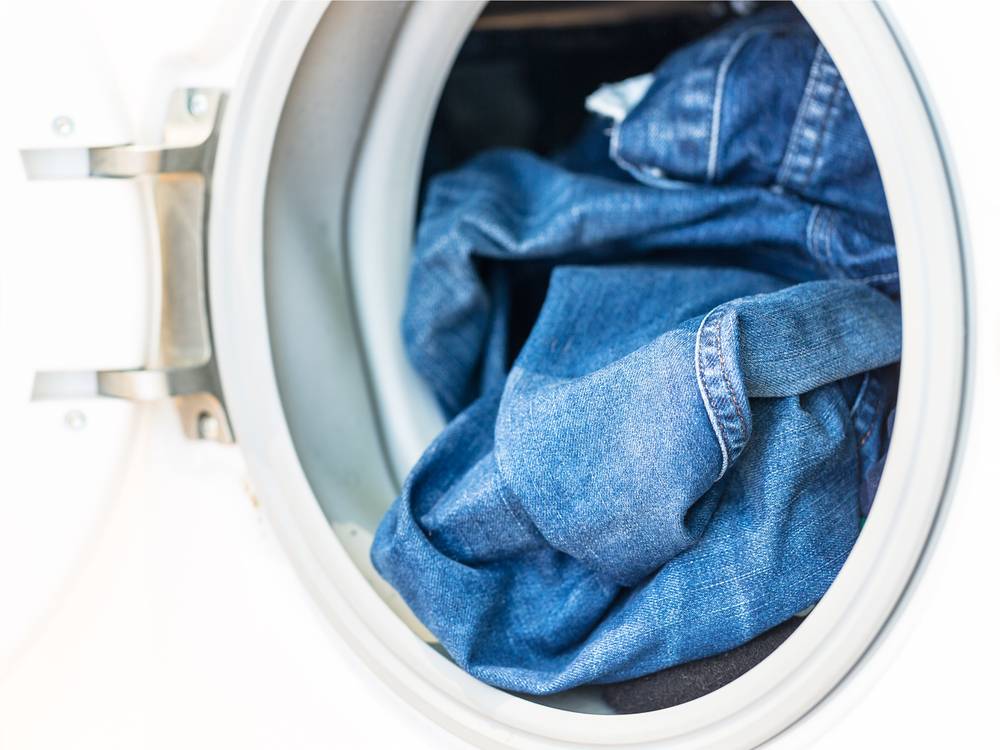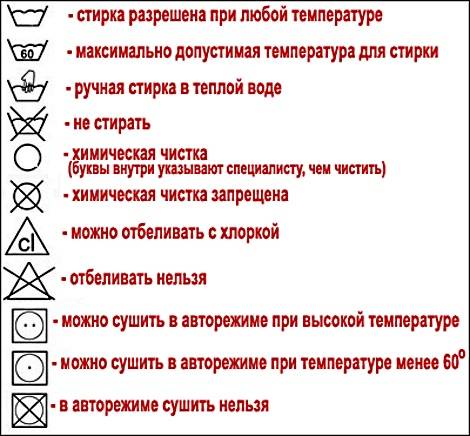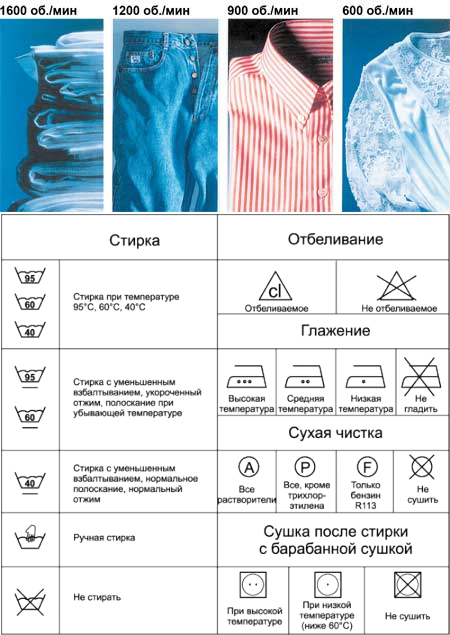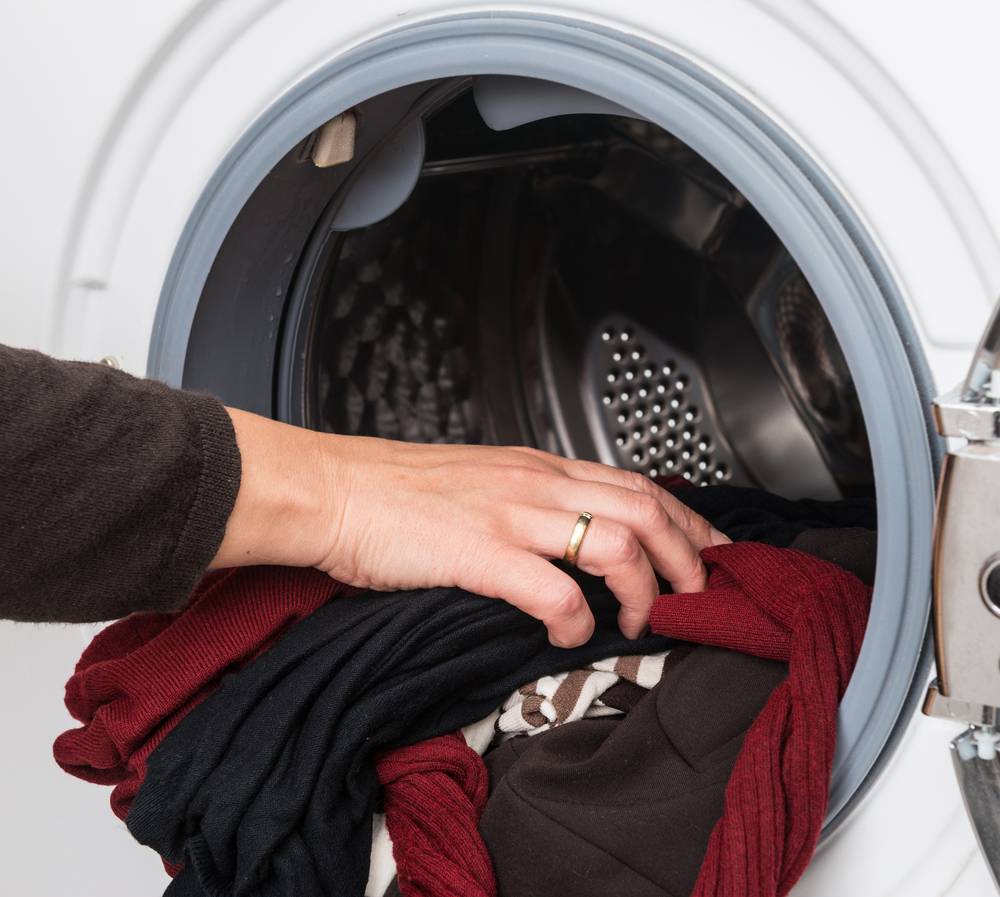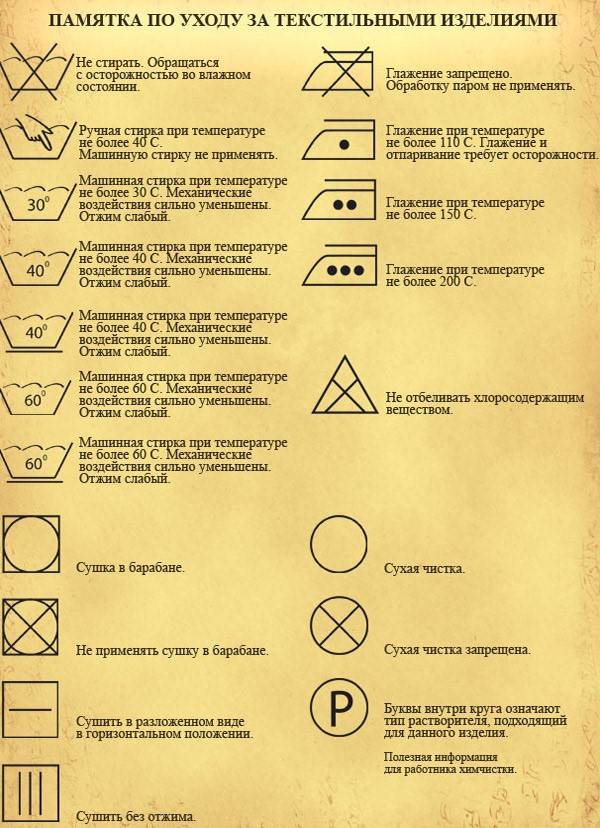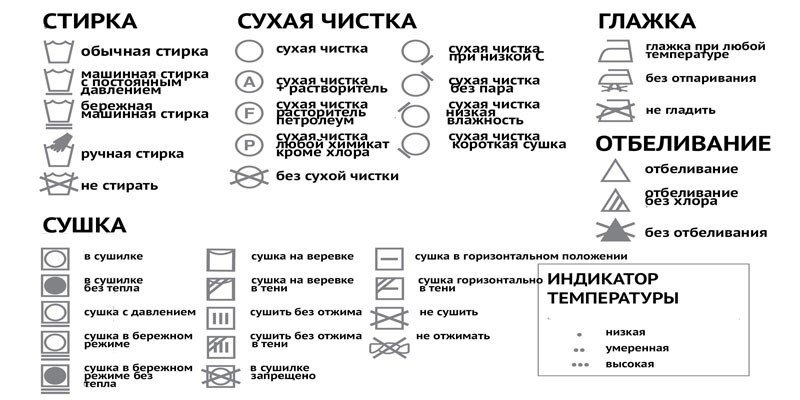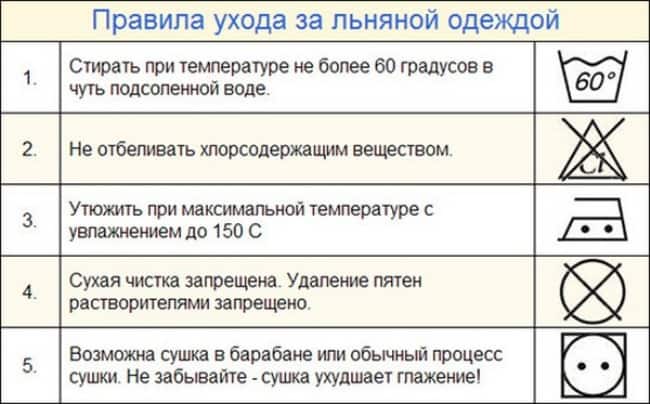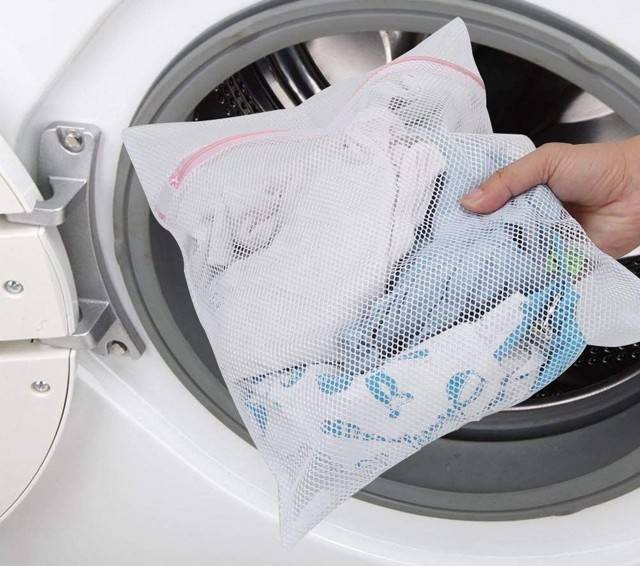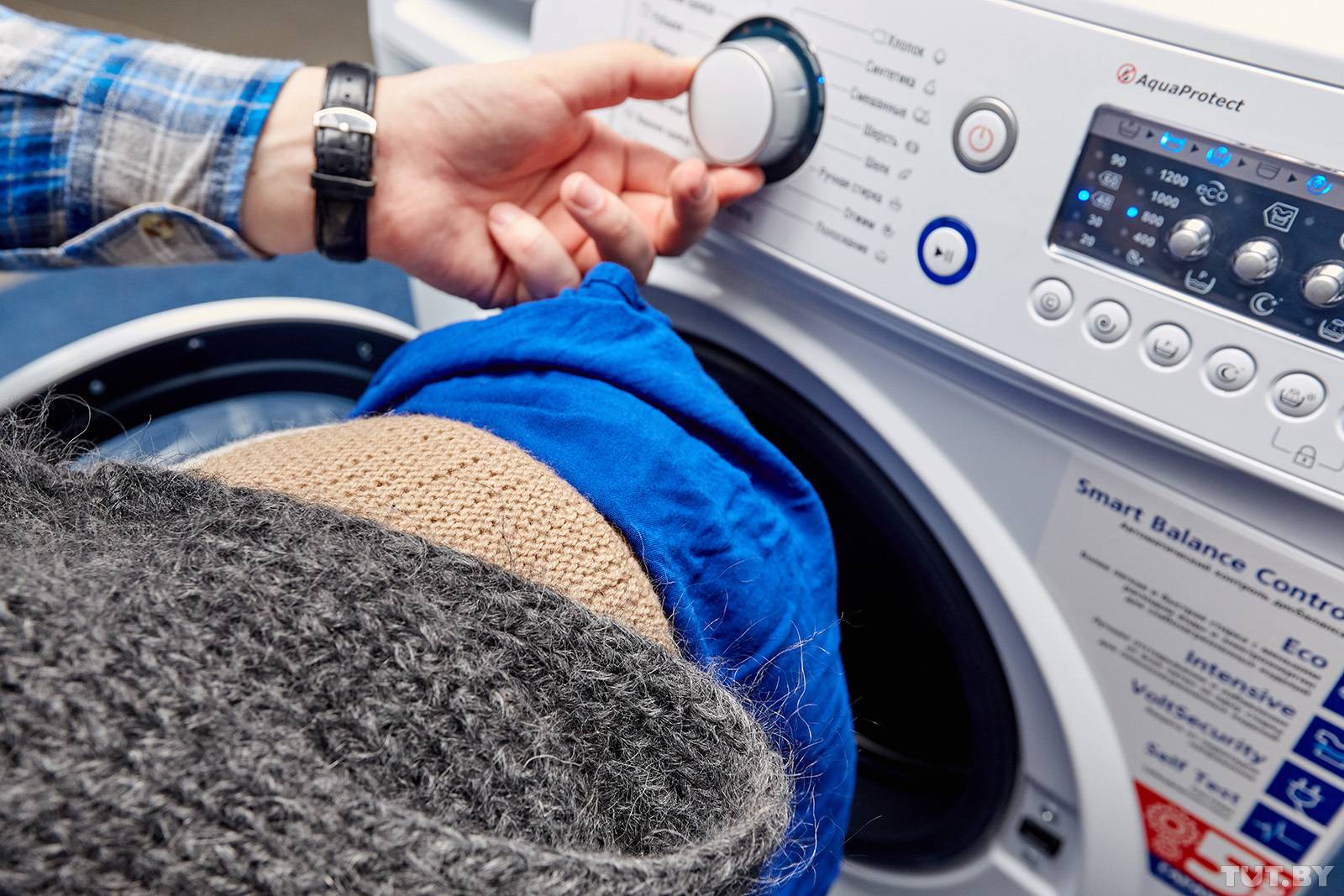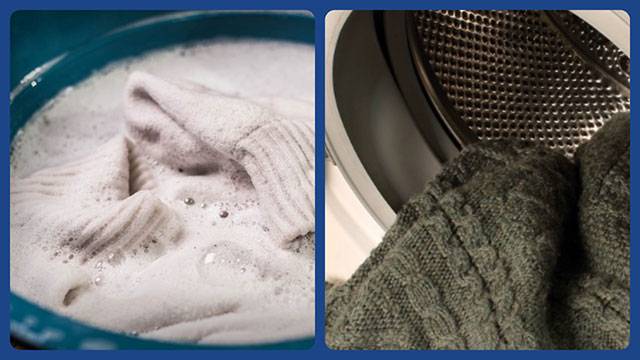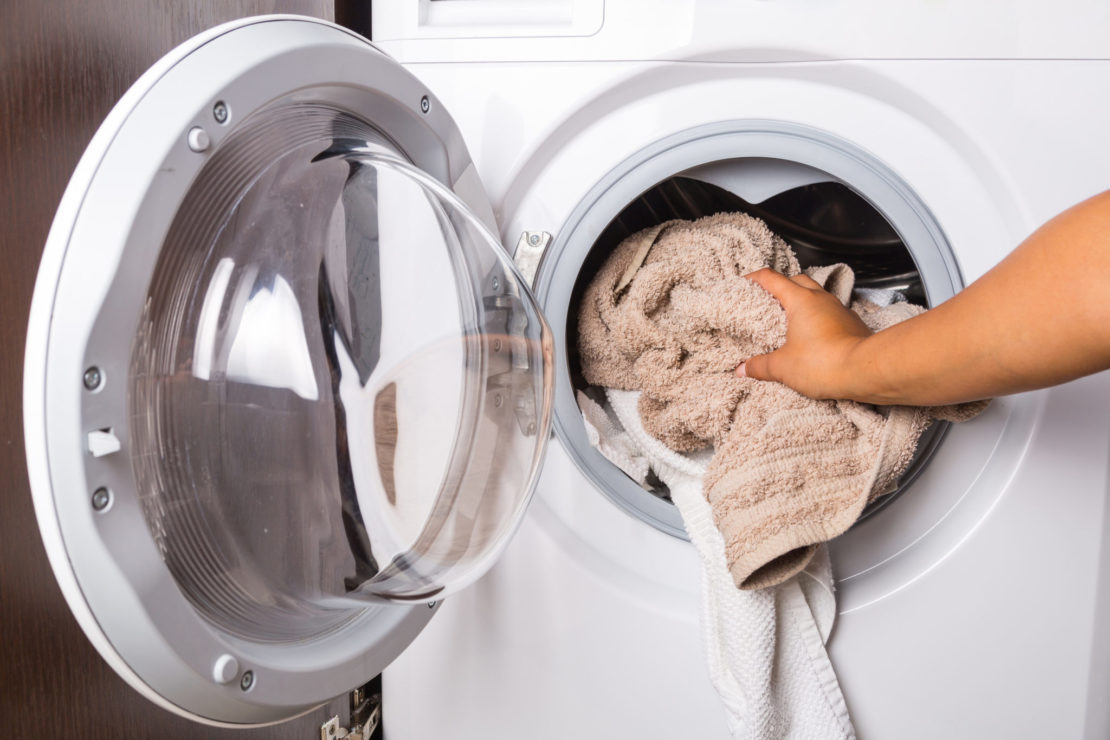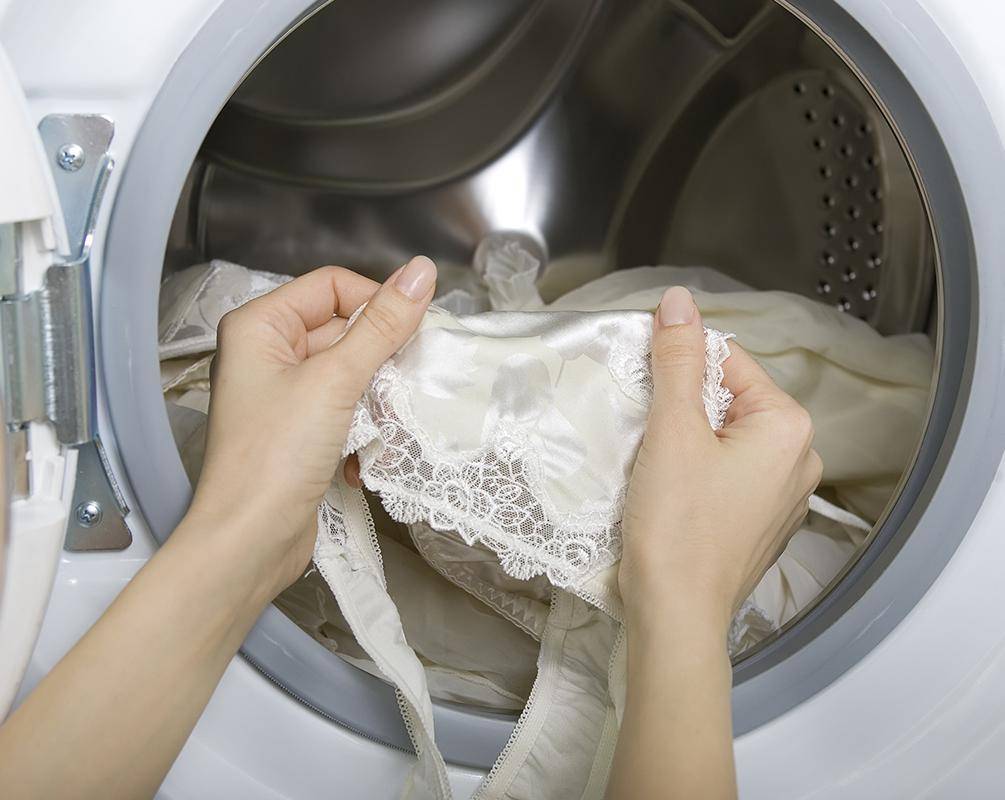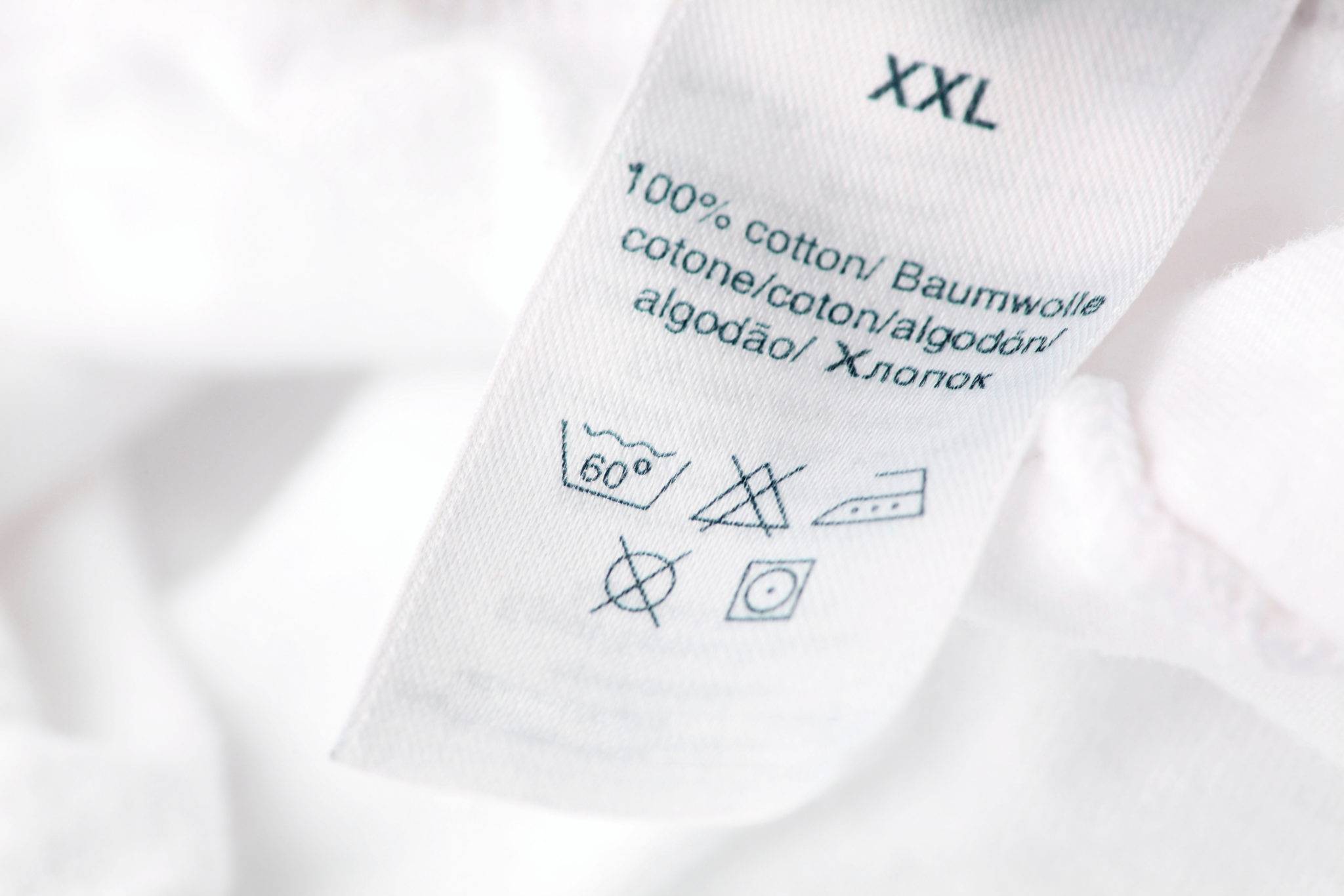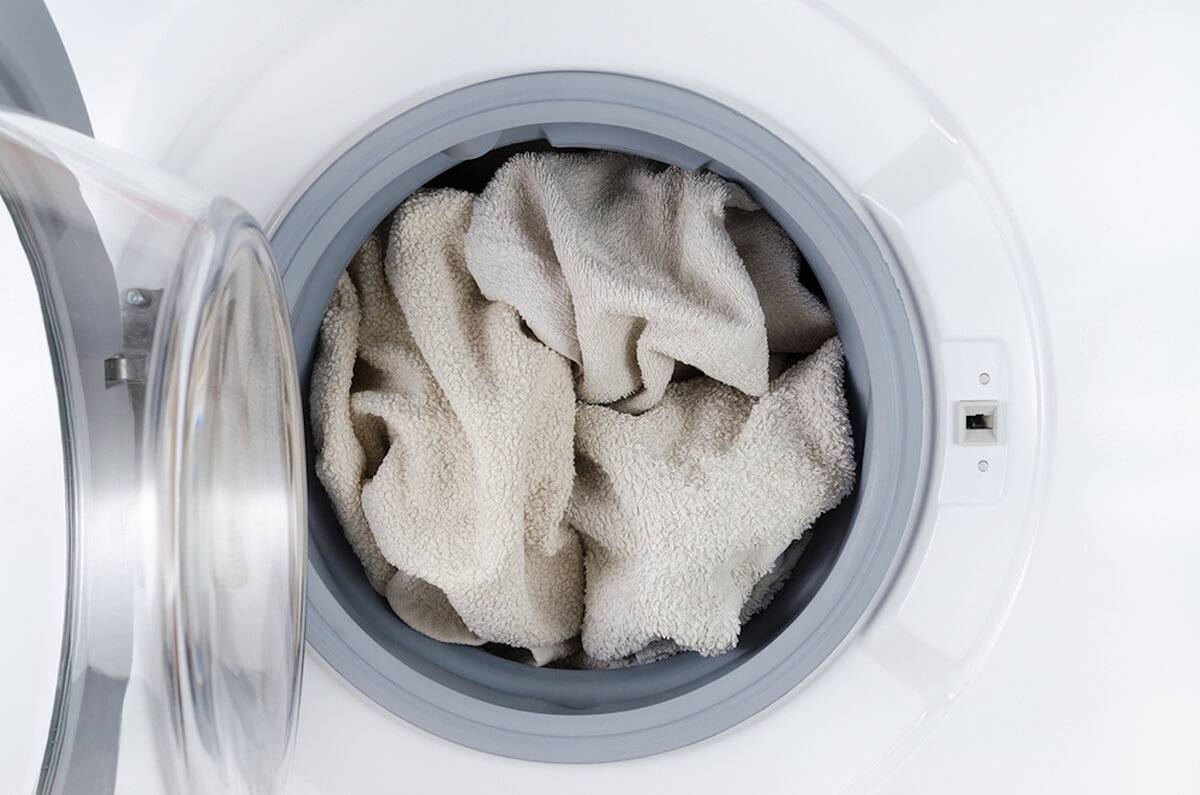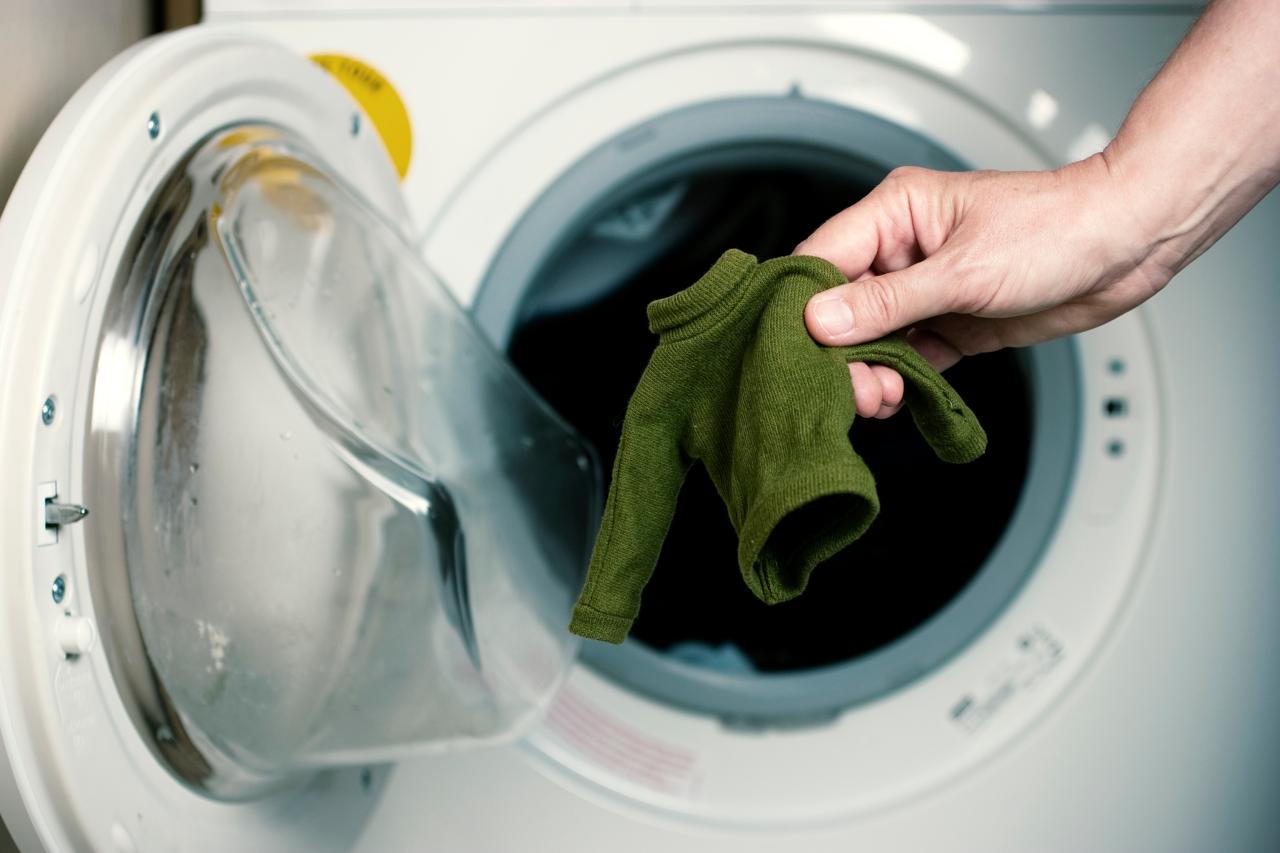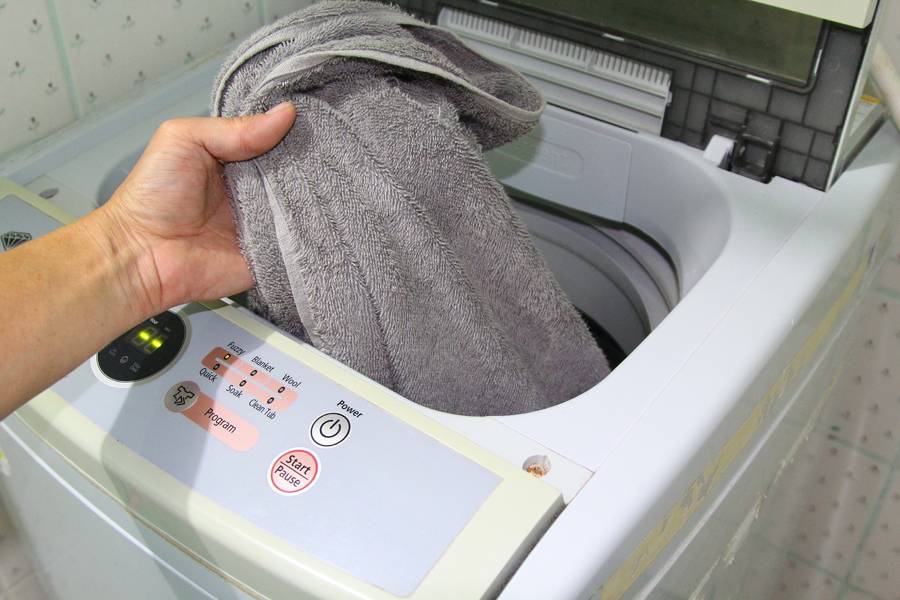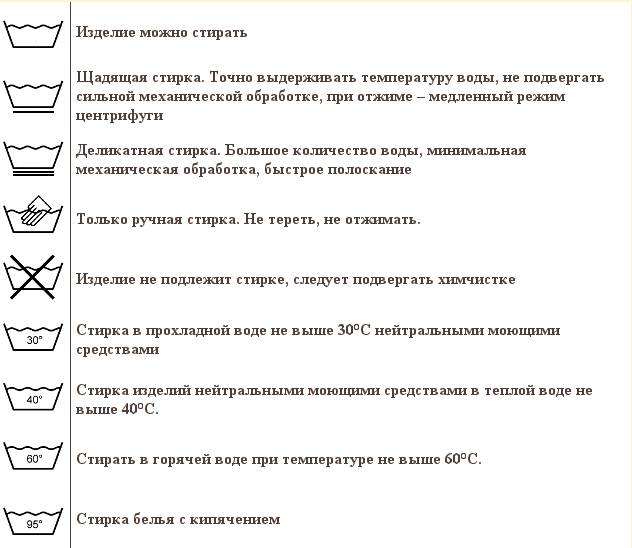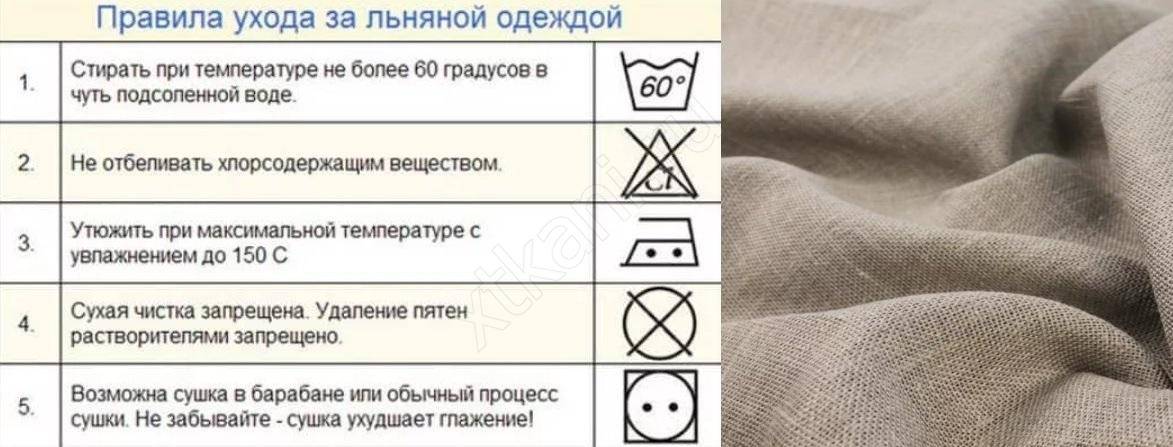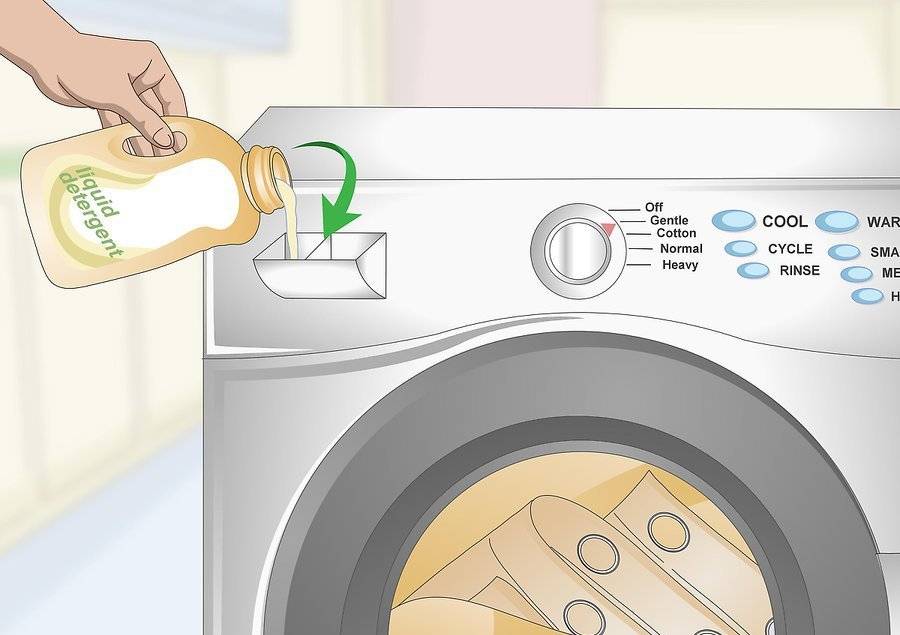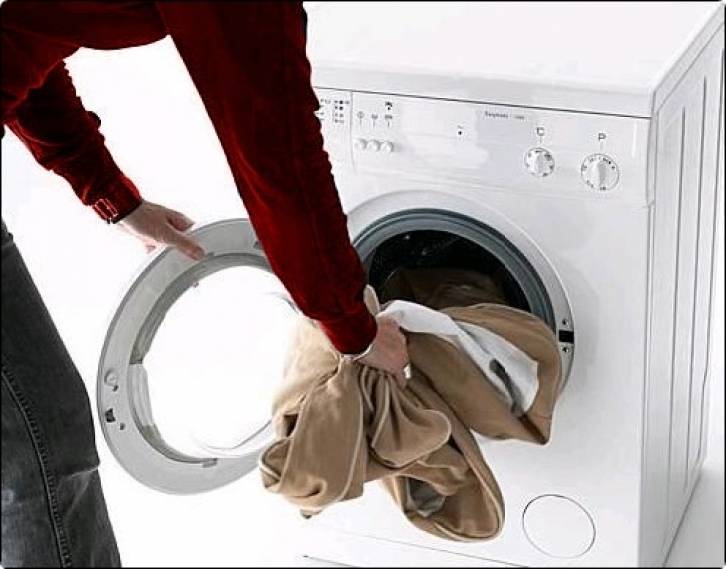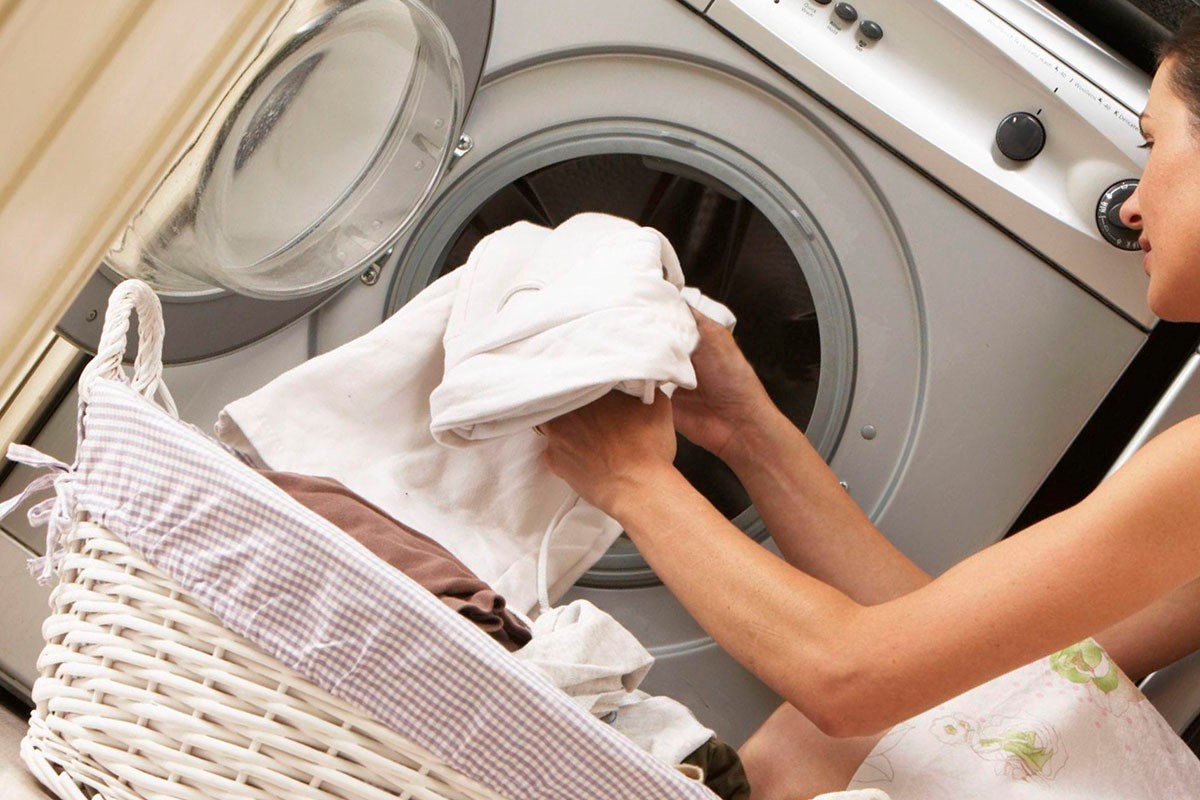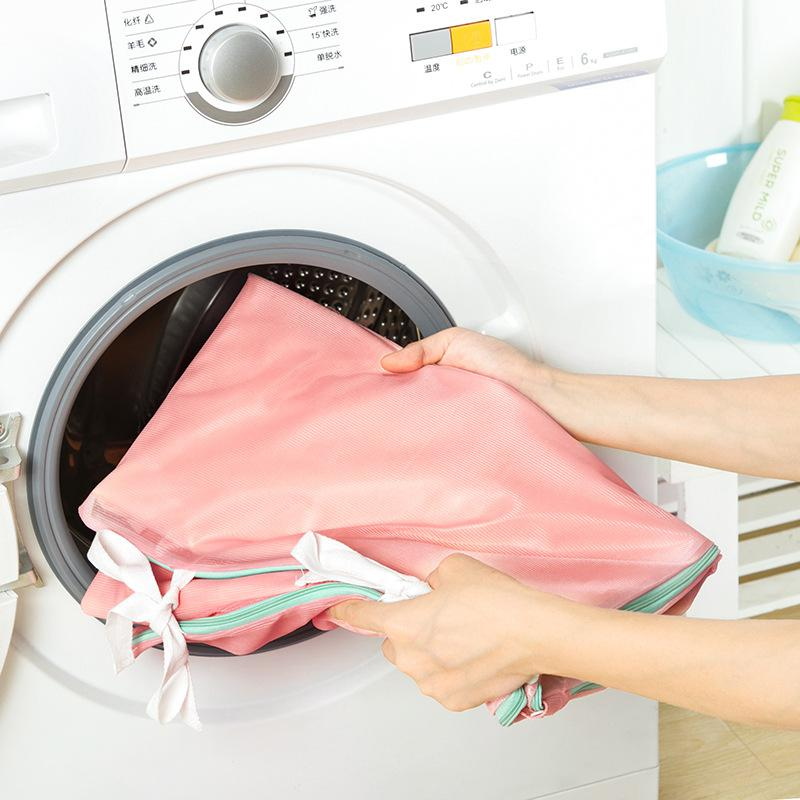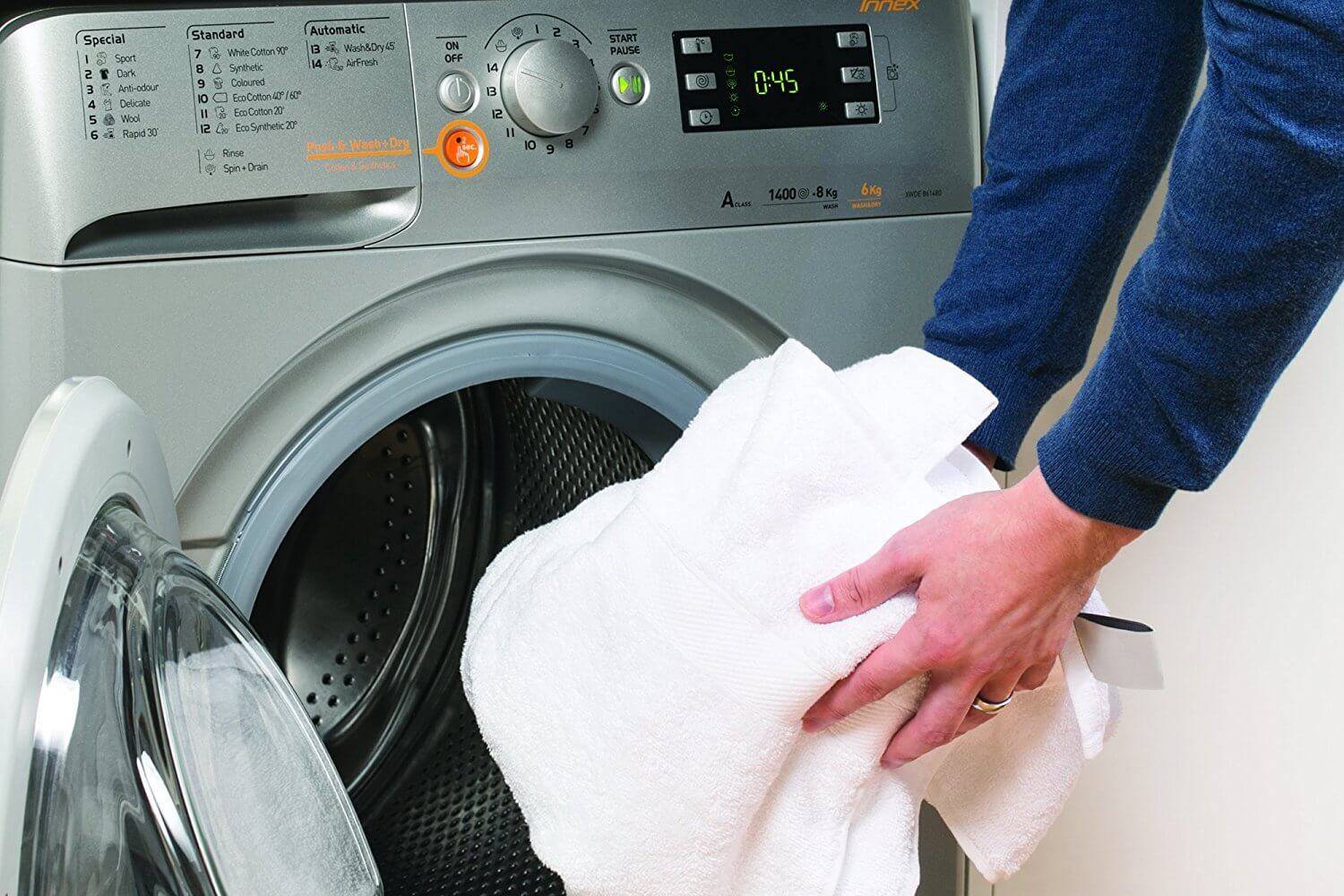Hand and machine wash rules
As mentioned earlier, dirt from linen can be removed both manually and in an automatic machine. If the latter has a program for delicate fabrics, then this will be enough so as not to harm the natural material.
Temperature regime
Wash linen so that it does not sit better at 30-40 degrees. This is especially true for colored fabrics for which too hot water is destructive. Linen fibers have a porous structure, and under the influence of high temperatures, the paint begins to quickly wash out of them. The fabric fades and takes on an unpleasant washed color.
The situation is simpler with absolutely white and unpainted material. For him, a mark of 60 ° C is permissible. If the contamination is too strong and cannot be washed at normal temperature, then you can even resort to boiling. In this case, you need to be prepared for the fact that the shrinkage will be at least 10% of the original size.
Detergents
Discard powders and concentrates containing chlorine. It is especially common in stain removers. The aggressive effect of this substance will thin the material, and it will lose its attractive appearance. If it is necessary to get rid of stains, it is better to wash the local dirt with soap in advance.
Preferably use mild cleaners:
- liquid gels have proven to be excellent in working with linen;
- for white, buy oxygen powder with bleaching function;
- for colored or embroidered linen, products with a note that they retain color are suitable.
Machine wash
Only use programs for delicate fabrics. The water temperature is not higher than 40 ° С for heavy pollution and 30 ° С for moderate ones. If the task is to reduce the thing in size, then you can stop at 90 ° C.
The rotation speed of the machine drum should be no more than 500 rpm
It is important that things in the vending machine are not packed too tightly: flax likes it when there is a lot of water. Optimally, the drum is loaded only 2/3 of its maximum capacity
Pay attention to this when you plan to launder voluminous curtains or bedding. Otherwise, things cannot be properly washed, they will crumple up and it will be difficult to iron them.
The spin can be turned off or set to minimum speed. High speeds may not spoil, but they can seriously crush the product. But the double rinse function, on the contrary, is recommended to be turned on. This will ensure that the cleaning agents are washed out of the linen.
Sort items by color. White and colored linen should not be loaded into the washing machine at the same time. Even with a delicate program, colored linen may shed a little during the first wash, which will ruin the light garment.
If the material has colored embroidery, then it should not be soaked, and it is better to put a handful of salt in the air-conditioned compartment. To help colored laundry retain their rich color longer, you can pour a spoonful of vinegar or citric acid into the rinse aid container before rinsing.
Manual
This is the best option for 100% flax without synthetic additives. If the material is not painted, then even a simple laundry soap is suitable for it. In some cases, it will be even more beneficial than washing powder.
Algorithm of actions:
- Take a container as large as possible and fill it to the top with warm water.
- If the item requires soaking, then leave it in water with the detergent added there for no longer than 1 hour. If necessary, you can lather up particularly stubborn dirt.
- Take out the laundry and place it in a separate bowl, in which the powder and 1 spoonful of vinegar have already been thoroughly diluted.
- Wash the product.
- Rinse thoroughly in cool water.
Powder or soap particles will oxidize and damage the fibers if left in them after cleaning. Therefore, the rinsing process is best done in several stages. First, in plain water, and then with the addition of vinegar (at the rate of 1 tablespoon per 2 liters of water).
Most housewives are wary of washing flax, as they are sure that it will shrink. Indeed, too high a degree can reduce your thing by one or even two sizes. But if you do everything right, then the material will only benefit.
Hand washing is more desirable, but if your machine has a delicate fabric care program, this will be sufficient. The main rule is that the temperature is not higher than 40 ° C and the drum rotates at a low speed. Make sure your powders are free of chlorine and avoid bleach.
Delicate wash in the washing machine
It is necessary to wash linen products at a temperature of no more than 60 degrees, if we are talking about undyed natural linen. For colored flax, a temperature of 30 - 40 degrees is preferable. The number of revolutions should not exceed 400 - 500 times, at higher ones, the item may be damaged, creases or folds that are difficult to iron out may appear on it.
Before you start washing, carefully look at the tag, it carries a lot of useful information, there is such a tag on any clothes. Sometimes the material of clothing contains synthetic components, respectively, the product is not 100% natural. The highest temperature at which linen can be washed is also always indicated on the tag. If you are in doubt about which mode to wash linen, you can stop at the mode of washing delicate fabrics. When washing, you can use laundry soap or powder for baby clothes, which will not aggressively affect the fabric. You should not use chlorine-containing bleaches, fabric fibers from this can easily lose strength, and this, most likely, will lead to a loss of attractiveness of the outfit itself.
It will also not be superfluous to use such a function in the washing machine as an additional rinse. The better you rinse the linen garment, the better it will look.
Colored laundry is slightly different. What should you remember?
Always wash colored items separately to avoid staining other linen garments. The powders and stain removers you use should only be for colored clothing. You should also not use the spin and dry mode, do it yourself after removing the clothes from the washing machine.
Preparing for washing
If the basket is filled with numerous kits, then before the procedure they need sort by fabric type and color
.
Types of fabric:
-
linen and cotton.
Cotton is used to make many types of fabrics. It perfectly absorbs moisture, washes easily and dries quickly. If the cotton, linen fabric is heavily soiled, then for washing, you should select a program at a temperature of 40, and if you need to thoroughly disinfect and obtain ideal whiteness, you should select a mode with temperature 60
... The maximum spin can be selected; -
satin.
The material is pleasant to the touch, of high quality and guarantees a sound sleep. It can be washed at 60 degrees. If for this you prefer modern powders and strong active additives, then the 40-degree mode will be the best option. Spinning can be medium or maximum; -
.
Many housewives wash silk products incorrectly, after which the fibers of the fabric deteriorate. It is possible to wash a silk bed only at a temperature of 30 degrees, using a water softener and detergents of medium activity, do not use bleach! It is advisable not to use the spin mode; -
synthetics.
The buyer prefers durability and affordable cost. These are the qualities that synthetic matter possesses. To wash it, you must select a mode with a temperature not exceeding 30-40 degrees
to prevent pellets from appearing on it.
Washing rules for flax
How long it will last depends on what kind of care is provided to natural fabric.
Before you start washing, it is important to read the recommendations for washing flax. If linen is washed under the conditions of using hard water and drying, the material will lose its original appearance and become unusable over time.
Hand wash - no matter how hard you try technical progress, it preserves the appearance of the thing better than machine wash. For washing in the machine, there are special modes designed for delicate washings, but they do not fully satisfy the requirements of the material for its care.
Flax reacts negatively to the chlorine content of powder or detergents. This component renders the material unusable and weak. Chlorine is used in stain removers, you cannot use them for chlorine. The most optimal way to care for linen clothes is to use baby powders or special detergents for delicate washing.
White ice is washed with an oxygen-based stain remover; if the fabric is colored, it will eliminate any stain removers. In order to avoid color loss, you need to know how to wash linen. Linen garments can become discolored and be sure to keep this in mind before washing.
To preserve color, you should use special powders for colored products, especially when it comes to flax. Like cotton fabrics, linen is washed on a delicate cycle in a washing machine using baby or delicate detergents.
Flax needs a lot of water, it is washed so that the product can rinse freely in water, this is the rule of washing linen. The abundance of water allows you to completely rinse out the powder and not leave streaks on the product.
Linen may shrink after washing, but the elasticity of the material allows it to return to its original appearance after you put on a garment or iron it.
In the process of washing flax, the main thing is to rinse it well.
Hand washing shoes
Even proper shoe care does not guarantee the absence of stubborn stains that need to be wiped off. This is not difficult.
An exception to this wash is suede shoes. It is not recommended to wet it, but special means are used for cleaning.
Shoes need to be prepared, for this they pull out the laces and insoles (they are washed separately). It is necessary to pre-soak them in bleach (no more than 40 minutes), rinse thoroughly and wash the stains with laundry soap.
Dry shoes are cleaned from dust and dirt with a brush. You can use an old toothbrush to wash the soles to get a good clean out of pebbles and dirt.
Powder or detergent is dissolved in warm water (40 degrees). It is soaked in soapy water for 20 minutes, the dirty water is drained. Shoes are placed in a basin with clean water and the dirty areas are carefully wiped with a soft sponge (brush).
Rules for washing flax in a washing machine
The best option for washing linen is gentle hand cleaning. With a lack of time and desire, you can wash linen in the washing machine. However, here, as well as when washing silk, you need to use the golden rule of washing delicate fabrics - using gentle programs and modes. The water temperature should not exceed 30-40 ºC, otherwise the paint will wash out. Leave the spin at around 400-500 rpm. At high speeds, the fabric can “chew” and form unattractive folds that are difficult to iron.
About the "correctness" of powders
When choosing a cleaning agent, look for soft liquid powders. Oxygen powder (bleaching powder) should be used for white linen clothes.
For colored, buy a color preserving compound marked “Color”.
Before using, be sure to study the composition of the product.
Use chlorine powders and stain removers with care. Colored fabrics require special scrupulousness
Simple rules
- Do not overload the drum of the machine by filling it 2/3 full. Sort clothes by color and type of material.
- Use laundry covers half full. The cover will help keep the look and fittings intact.
- Linen is absorbent, therefore it is washed in a large amount of water, and it is advisable to turn on the additional rinse function. Powder residues on the fabric can significantly shorten the life of the product.
- If you don't have a suitable powder for colored items on hand, add a couple of tablespoons of table bite or citric acid to the tray instead of rinse aid.
- Follow the recommendations on the label for what temperature to wash your linen at and which mode to use when ironing.
- Dresses and shirts with embroidery must not be soaked or boiled. Add salt to the rinse aid compartment.
- Hard water, harsh washing powder and too long drying are the main enemies.
How to wash linen so that it does not shrink?
The truth is that 100% natural linen shrinks under all conditions. If the material contains synthetic fibers, then the degree of shrinkage is low, and immediately after trying on the thing returns to its usual size. To return a natural fabric to its original state, it is enough to iron it through a dense fabric or gauze, rolled several times.
The final size and appearance are largely dependent on the delicacy of drying and ironing the laundry.
How to wash linen correctly?
A fabric woven from natural linen fibers is extremely vulnerable. It is useful to know what risks are in store for linen items during water procedures.
Molting
Violation of the rules of care can lead to a change in the uniformity of the color of the fabric - it can shed. That is why it is recommended to use powders to which special granules are added to preserve color. Products for delicate fabrics are also suitable. Recommended:
- Use large volumes of water. The larger it is, the less likely the color changes. There should be enough water for things to float freely in it.
- If you use an automatic washing machine (CMA) or an activator machine, you need to load the tank at 2/3 of the maximum load.
- For safety net, it is better to use special bags - they need to be filled to 50% of their volume.
- Rinsing should be repeated and thorough. To make the color of the dyed material brighter and richer, vinegar is added to the water.
At what temperature?
The ideal washing temperature is 30-40 ° С
This is especially important if the material is colored. Too hot water will ruin the color, and boiling water can completely leave the fabric without it.
For exact temperature limits, see the icons on the label.
Removing stains
There are stains that cannot be removed with conventional products. It will be easier to remove them if you start removing them immediately after occurrence. Before using the stain remover, you need to do a test - wet an inconspicuous tissue gap in it. After waiting 5 minutes, rinse the wet area. If there are no discoloration, the stain remover is good, if there is, you need to look for another remedy. It is not recommended to pour the stain remover into the washing machine - it must be used locally, and then rinse the treated items thoroughly.
Does linen shrink when washing?
Material without synthetic additives is prone to shrinkage after exposure to water. This problem is not critical - the clothes quickly return to their original sizes during wear. Iron through heavy fabric to speed up the process. How to wash linen clothes so they don't shrink? Just don't use hot water. Wash only in water at the recommended temperature - 30-40 ° C.
How to dry?
It is not recommended to squeeze and twist natural fabrics. The water is removed by smoothing the product and hanging it on a hanger. Drying Tips:
- The room must be ventilated;
- Avoid direct sunlight - flax burns out in the sun;
- Don't close the windows. The lack of oxygen will negatively affect the appearance of the products - shrinkage will occur;
- Do not overdry - a little moisture is necessary for ironing. Ironing slightly damp products is much easier;
- Iron with a well-heated iron. Finish ironing at the moment when the material becomes perfectly even, smooth, but there will still be a minimum amount of moisture in it. After that, the clothes are hung up to dry or laid out horizontally.
The addition of synthetics will make it easier to take care of things - they are easier to smooth out, do not shrink. But such fabrics still lose the main advantage - they can no longer be called natural and hypoallergenic.
Flax properties
Flax is translated from Latin as "the most useful", this is not accidental. It is considered one of the first "domesticated" plants and is valued for its medicinal properties. Due to the luxurious amount of vitamins and beneficial substances in its composition, flaxseed exhibits antibacterial and even antifungal properties.
For women over 30, flaxseeds can reduce the risk of breast and bowel cancer. In addition, the beneficial herb improves skin and hair color, not to mention its gut health benefits.
However, flax is used not only for treatment in folk and official medicine, but also for the manufacture of natural summer fabric. The dramatically increased popularity of such material is understandable - more and more people are striving to be closer to nature. Linen is best suited for this.
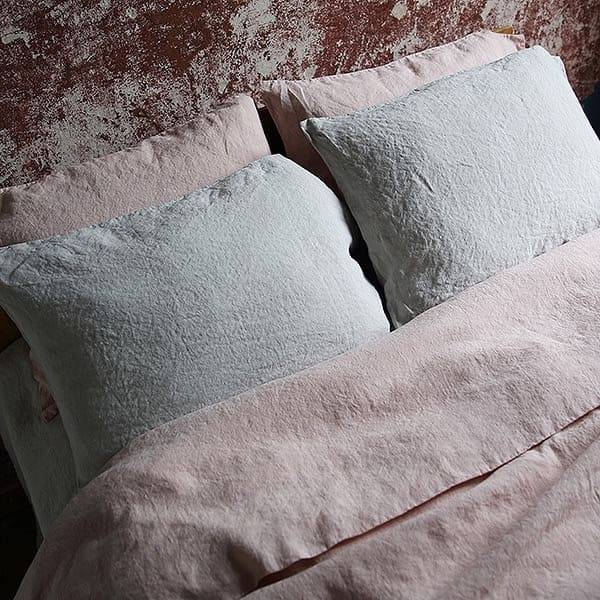
Due to its properties, it is used in many areas. This can be both sewing clothes and making bed linen, tablecloths, etc.
Washing sequence
Rule 4. Stages of washing by hand
Any hand wash, regardless of the number of items and the characteristics of the washed fabrics, consists of several stages.
Instructions
will help you foresee all the nuances and simplify the task:
|
Image |
Procedure |
|
Step 1 Decide on where to wash. |
|
|
Step 2 Sort things out. If you are going to wash wool products, turn them inside out. Also don't forget to check your pockets! |
|
|
Step 3 Prepare a container for washing. |
|
|
Step 4 Prepare detergents |
|
|
Step 5 Dilute the chosen remedy |
|
|
Step 6 Be aware of the water temperature. |
|
|
Step 7 Submerge things in a basin with |
|
|
Step 8 Leave things soaked for a while Do not overexpose soaked items to an unpleasant odor, otherwise you will have to start washing from the beginning. |
|
|
Step 9 Heavy pollution |
|
|
Step 10 Rinse the laundry after washing If desired, add fabric softener to the water at the dosage indicated by the manufacturer. |
|
|
Step 11 Gently squeeze out excess water |
|
|
Step 12 It remains to hang the laundry until it is completely dry |
Rule 5. Delicate hand wash
Washing delicate fabrics requires special attention.
Fragile and delicate materials can only be washed in cold or lukewarm water
with the addition of a small amount of detergent. For example, 1 tablespoon of powder in 5 liters of water.
note
:
-
silk and lace fabrics
it is better to wash in liquid detergents for delicate washing; -
batik and woolen embroidery
can only be washed in cold water; -
if you use bleach or stain remover for washing
- add a tablespoon of hydrogen peroxide to the water; if you are washing an embroidered product - a tablespoon of lemon juice or vinegar.
Delicate items should not be actively rubbed and rinsed.
... Therefore, I recommend adhering to the following washing sequence:
- Dissolve the powder in water.
-
Submerge dirty things in a basin.
and leave for 5-10 minutes. -
Move things carefully, without twisting or shaking
into a basin of clean water.
- Leave it on for 5 minutes.
- Transfer items to clean water and rinse gently.
-
Spread out a terrycloth towel and put the washed items on it,
so that the water is absorbed.
-
If the fabric is susceptible to deformation
(may stretch) - leave the garment in a horizontal position, changing the wet towel with a dry one if necessary. If there is no such threat, hang things up and dry them at room temperature.
Selecting the mode and temperature of water heating
Linen can become discolored and tough after being washed incorrectly.
The best way to clean linen is hand wash. A faster, but less gentle way in relation to the fabric itself is to wash in the washing machine at low speeds.
The maximum temperature at which linen should be washed is 40 ° C. If the item is colored or has tinted areas, it is best not to increase the washing temperature over 30 ° C. This is due to the porous structure of the material, which, when exposed to high temperatures, poorly retains and rejects the dye.
When washing linen, the use of chlorine or chlorine-containing bleaches is strictly prohibited. If there is a compelling need for bleaching, it is recommended to use environmentally friendly bleach with sodium percarbonate, which effectively removes dirt from the fabric using oxygen.
How to wash colored linen items?
Choosing the right temperature is the key to successful washing of linen items.
Colored linen items can lose color during the wash process. Especially when the temperature regime is violated and the wrong detergent is selected. To preserve the original color of the product, it is recommended to use washing powders, which include special colored granules.
These particles are found in almost all formulations designed to clean delicate, delicate or colored fabrics.
When spinning linen, it is advisable to include an additional rinse mode in the washing program. This will remove excess detergent particles. When rinsing colored linen, you can add a “cap” of conditioner to soften it.
When washing by hand, remember the following nuances:
- Washing linen requires a lot of clean water, since the material itself has high absorbent properties.
- After cleaning, you should rinse the item under running warm water (3-5 minutes) or in a small basin with a constant change of water. This will rinse out all powder and detergent particles.
- When rinsing colored items, you can use a little vinegar. This will bring back the brightness of the colors and make the fabric softer.
If linen does not contain various synthetic additives, then this may give a slight shrinkage, which will disappear after an hour of wearing. In order not to wait for natural stretching, you can steam the thing through damp gauze.
What to do with stains?
If the stains are fresh, then removing them is not a problem.
Removing stains and dirt from linen items is no big deal. In many ways, the cleaning process is highly dependent on the nature and freshness of the contamination. The fresher the stain, the easier it is to remove from the structure of the material.
For this, a drop of stain remover is applied from the wrong side of the product. After 2-3 minutes, the product is removed according to the instructions. If the color has changed even a little, then the composition is not suitable for a particular thing and its use will do more harm than help remove stains.
In addition to applying the stain remover to the fabric itself, you can add 1-2 measuring containers directly to the drum of the washing machine. It is recommended to carry out additional rinsing after the end of washing.
Basic rules for drying and ironing
Improper drying and ironing of linen items can lead to the fact that the product quickly loses its shape, tarnishes or even breaks from accidental movement.
To prevent this, there are a number of important points to keep in mind:
- During the spinning process and before drying, do not twist the linen garment.
- To prevent shrinkage, things should be dried in a well-ventilated area, on a balcony or loggia, protected from direct sunlight.
- Ironing of things should take place until the fabric is completely dry. If necessary, you can use damp gauze and another steaming cloth.
- The use of the steaming or humidification function is highly recommended. The use of manual or stationary steamers is allowed.
Do not iron the product until it is completely dry. After removing the folds from the front side of the garment, hang or unfold the garment until it dries completely naturally.
How to wash without ironing
If you did not use the strongest chemicals for washing the laundry, then you can not iron the products. Just shake well and hang the canvases gently outdoors, but not in bright sunlight.
If ironing is necessary, then the materials should be ironed slightly dry from the wrong side, especially if there is a pattern.
Knowing all the rules of washing, housewives will be able to achieve incredible coziness and comfort in their home!
At first glance, washing bed linen is a simple occupation that does not require a lot of knowledge and practice. It is necessary to purchase them for those who want to learn how to properly wash bedding more than once, so that it retains its original fresh shape and colors. The hostesses have always done this at home - by hand, when the bed was still produced strictly white and it was easier to learn how to wash it. Today the bedding market offers us a variety of fabrics, colored and mixed linens; duvet cover or pillowcases can be purchased separately. Let's see how you need to take care of all this correctly.
Bed linen should always be clean, so you need to learn how to wash it correctly.
If you have purchased a set of bed pillowcases for the joy of yourself and your household, then immediately after that the question arises, how should it be washed at home?
By hand or on a washing machine? Very often and in what mode in the machine? At what temperature, is it possible with a duvet cover? General tips will help us with this, which it is better to familiarize yourself with before the first wash at home:
Even at the stage of unpacking our pillowcases or duvet cover, you need to immediately put aside and save the label at home, where the manufacturer tells how to properly wash such linen, i.e. general recommendations for the care of the product. The weight of the dry set can also be indicated here - this will be useful to us in the future.
If the pillowcases that we are going to wash well are decorated with bright embroidery, then before washing in the machine they need to be placed in a washing bag - you can buy it in the departments where products for washing, ironing, cleaning, etc. are sold. To clean your pillowcases, it's best to purchase a large bag. You can do without it if you intend to wash it by hand.
It is recommended to turn colored products inside out. So our colorful pillowcases and duvet cover will stay bright for a long time, and the pattern will remain clear. From the inside, it will not come into contact with the walls of the machine and other linen, i.e. friction will be kept to a minimum.
In the corners of a pillowcase or duvet cover, small debris and dust, fluff from the blanket and pillow are constantly accumulating. It will be possible to wash the product well by shaking it all out before washing, both by hand and on a washing machine
This will prevent the pump and filter of the machine from clogging.
No matter what the temperature in the machine was during the wash, a new set always shrinks, especially if it is sewn from natural fabrics. Therefore, do not be upset if this happened - this is normal.
Calico and cotton will shrink regardless of whether you washed them by hand or in a special mode in a washing machine.
Despite the assurances of advertising, conditioners and rinses, especially if the laundry is often processed in the washing machine, reduce the strength of the material. Therefore, this should not be abused.
If you like to give your laundry care to the washing machine, then do not mix different fabrics. Polyester will cling to the fibers of natural products, thereby making them more rigid. This is especially true for satin.
The drum of the washing machine should be loaded halfway. You can use two duvet covers instead of three, especially if the linen is heavily soiled. So the washing will be effective, things will wring out better and it will be easier to iron them.
If possible, it is better to dry the duvet cover or pillowcases outdoors, under the sun. If you do this often, then turn the color inside out so that it does not fade. Ultraviolet light of the sun's rays disinfects linen - this is important for children's clothes
It is also recommended to iron them at a high temperature, paying attention to the seams.
When asked how often is it better to wash the bed? If this is children's underwear, then it is better to do it once a week or two, and the adult version is enough once a month.
How to wash linen clothes?
The structure of the woven fabric is easily damaged, so hand wash is the best option for linen garments. Linen has a big advantage - with each subsequent wash, it becomes softer and more pleasant to the touch. The main thing is to observe the temperature regime and use good detergents.
We erase by hand
This is the best option for natural fabrics. Procedure:
- Stains must first be removed with a stain remover;
- Check your pockets, take away any excess. Fasten the zippers;
- Fill the basin with warm water, dissolve the powder in it;
- Soak white items for 30 minutes. Colored wash without soaking;
- Wash gently;
- Rinse several times until the powder is completely removed;
- Do not wring out. Hang or lay to dry.
How to machine wash linen?
Housewives are not in vain worried about the question - is it possible to wash linen in a typewriter? Without knowing the rules of washing, you can easily ruin your favorite clothes, curtains, etc. Observe the following guidelines:
- Loading the machine - 2/3 of the volume. Everything is sorted into white and color. Place laundry in laundry bags.
- Use the extra rinse function.
- If there is no special powder for color, add two tablespoons of citric acid or the same amount of vinegar to the rinse aid container;
- Set the recommended water temperature and select a delicate cycle.
The main hazards for linen dresses and curtains are high temperatures, aggressive powders, long drying times and hard water.
Useful video:
If you follow the rules of care, you can wash linen clothes even in the SMA - without prejudice to their integrity and appearance.
Badly
Interesting
Super
2

